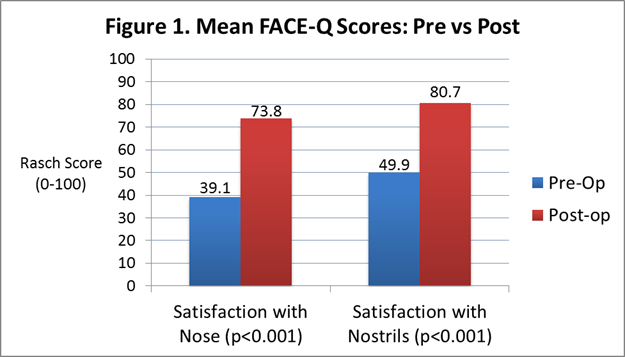|
|
|
|
|
Back to 2015 Annual Meeting
Measuring Satisfaction with Appearance: Validation of the FACE-Q Scales for the Nose, Forehead, Cheekbones, and Chin
Jonathan A. Schwitzer, MD1, Anne F. Klassen, DPhil2, Stefan J. Cano, PhD3, Stephen B. Baker, DDS, MD4, Charles East, FRCS5, Andrea L. Pusic, MD1.
1Memorial Sloan-Kettering Cancer Center, New York, NY, USA, 2McMaster University, Hamilton, ON, Canada, 3Plymouth University Peninsula Schools of Medicine and Dentistry, Plymouth, United Kingdom, 4Medstar Georgetown University Hospital, Washington, DC, USA, 5UCL, London, United Kingdom.
Purpose: Accurate and reliable measurement of patient-reported outcomes is crucial to ongoing practice improvement and clinical research in facial aesthetics. The FACE-Q is a new patient-reported outcome instrument (PRO) composed of numerous independently functioning scales and checklists designed to measure outcomes important to facial aesthetic patients. Here we describe the development and validation of five additional FACE-Q scales.
Methods: The FACE-Q was developed according to international guidelines for PRO instrument development. Through qualitative methods, concepts of interest to patients were identified and used to form scales measuring satisfaction for the following anatomic facial areas: forehead (6-items), cheekbones (10-items) cheeks (10-items), nose (10-items) and nostrils (5-items). These scales were field-tested in 10 plastic surgery and dermatology practices in Canada, USA and UK between 2010- 2014. Rasch Measurement Theory analysis was to evaluate reliability and validity.
Results: 393 patients were recruited (282 female, age 18 to 80 years, mean 39.6, sd=15.3). These patients provided 413 data-points (pre/post completions) as follows: Chin = 47/37, Nose/Nostrils 103/79, Cheekbone 45/106, Forehead 27/43. Procedures included rhinoplasty (170), facial injectable/filler (115), facelift/necklift (44), orthognathic surgery/genioplasty (40), browlift (38), blepharoplasty (34), autologous fat grafting (10), cheek/buccal fat reduction (9), skin resurfacing (7), and eyelash treatment (4). All 5 FACE-Q scales were found to be reliable and valid. Specifically, all 41 total items had ordered thresholds, 35 had item fit statistics within the recommended criteria of + 2.5 and all had non-significant Chi-square p-values (all items retained). Scale to sample targeting showed that each construct mapped out a clinically meaningful construct for patients. The Person Separation Index and Cronbach alpha values were 0.88 or higher. As an example of sub-group analysis, among patients undergoing rhinoplasty, Satisfaction with Nose and Nostrils scores (range 0-100) were significantly different in the pre- to post-surgery groups, indicating greater Satisfaction with Nose and Nostril after surgery. Specifically, Nose scores were 39.1 (sd 16.6) pre-op and 73.8 (sd 23.1) post-op (p<0.001), and Nostril scores were 49.9 (sd 28.8) pre-op and 80.7 (sd 24.9) post-op (p<0.001) (Figure 1).
Conclusions: The FACE-Q was developed to provide the research and clinical community with a comprehensive outcome measurement tool for facial aesthetic patients. These 5 condition-specific scales described show preliminary evidence of validity and reliability. Future research using these scales in clinical trials is recommended.

Back to 2015 Annual Meeting
|
|




